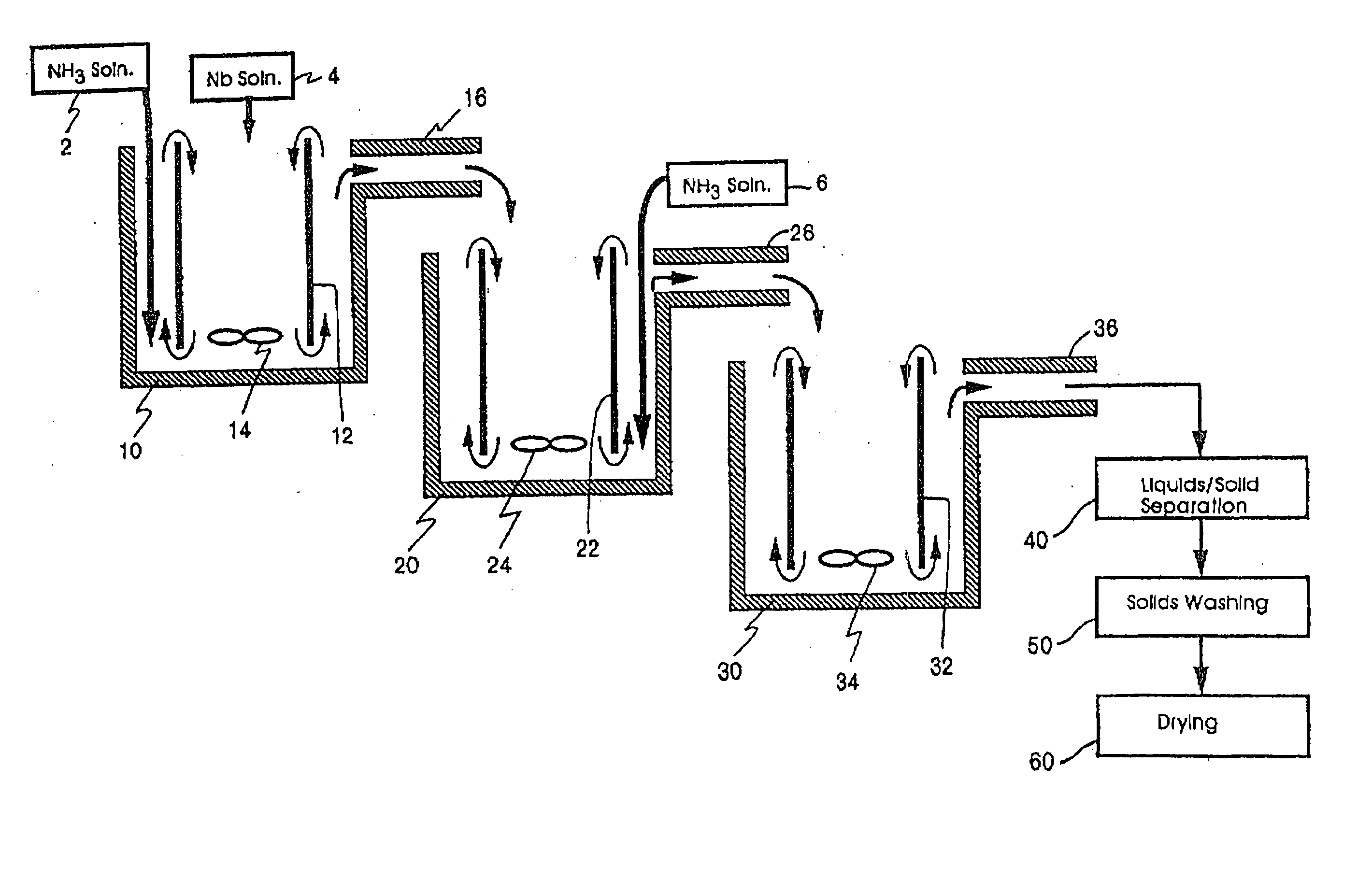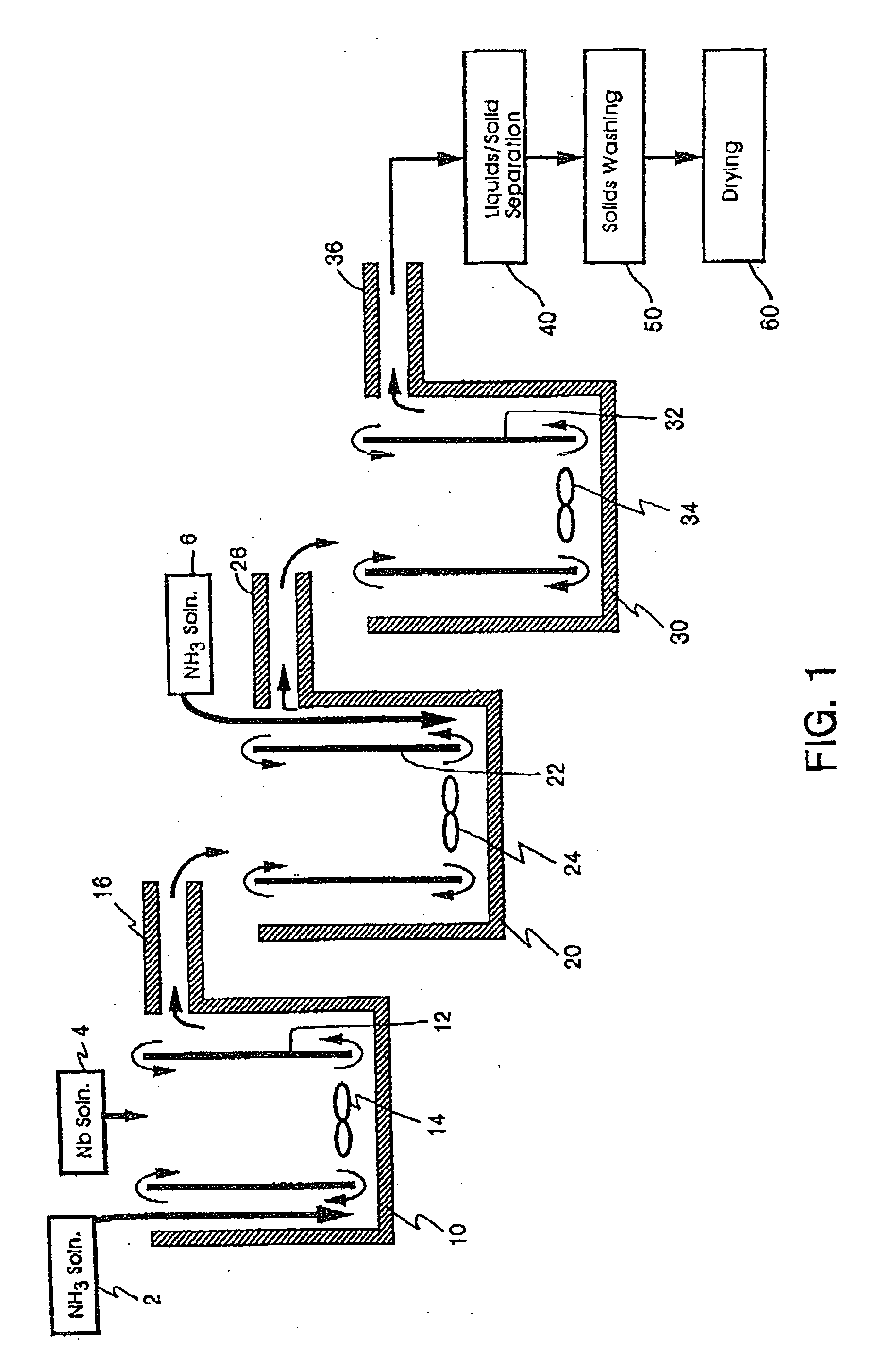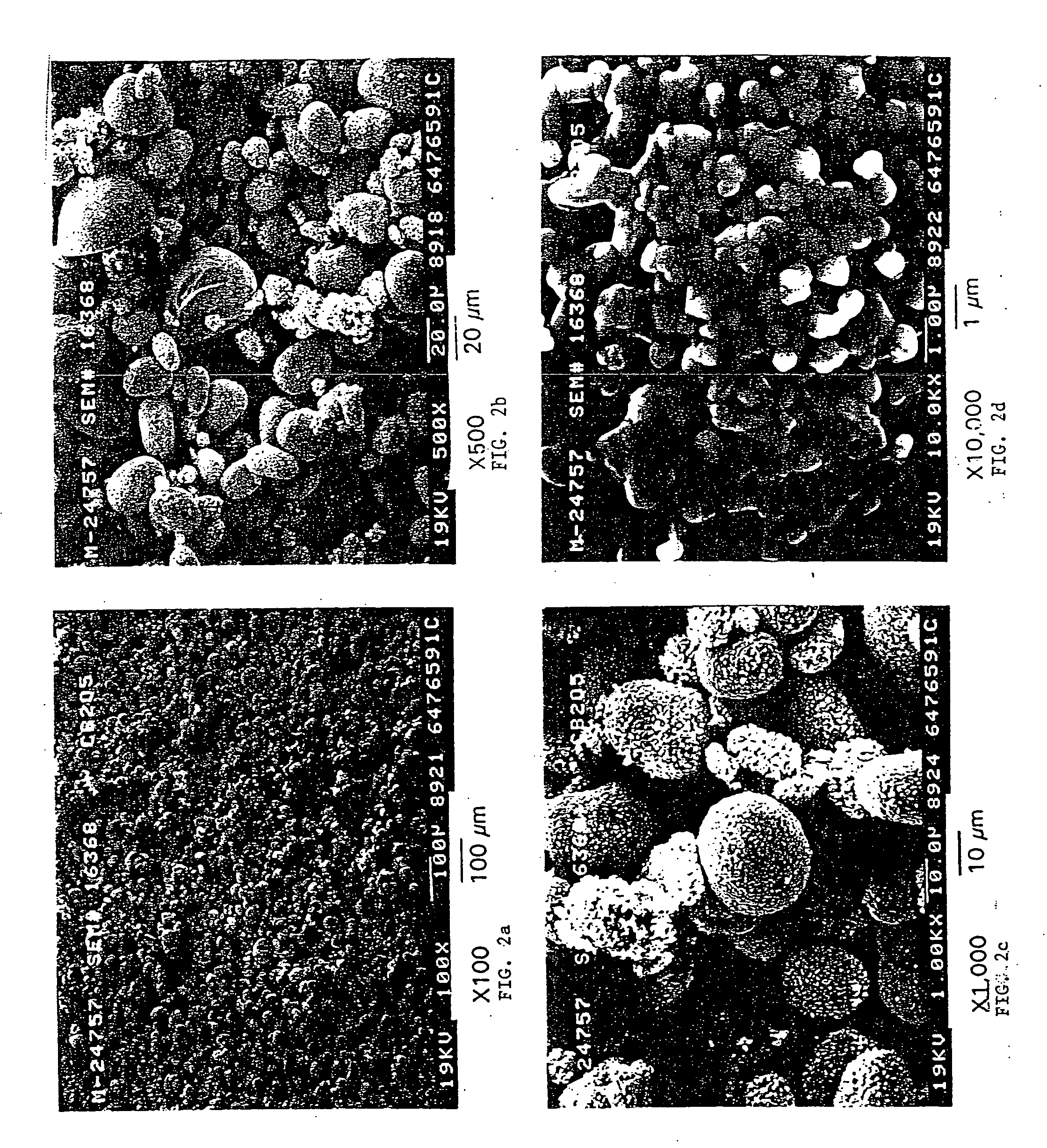[0244] Three 1500 ml (milliliter) plastic beakers were utilized as the first, second, and third reaction vessel. Working volume of the reactors was approximately 1000 ml. The plastic beakers were heated by hotplates in a double boiler type set-up using an outer container surrounding each
beaker. Either water or Dowtherm®, a registered heat exchange product of Dow Chemical Co., was utilized in the outer containers for
heat transfer and control depending on temperature requirements. In order to obtain a draft tube set-up, an inner tube with flights (or baffles) was utilized inside each
beaker.
[0291]
Stock solution of fluorotantalic acid (concentration of 87 g.
tantalum pentoxide /
liter) and 0.7% by volume EDTA was added to reactor 1 at a
constant rate.
Stock solution of 30%
ammonium hydroxide (NHOH) was added to the first reactor at an automated rate to achieve an average pH of 9.51. The average temperature of the reactants in reactor 1 was 55.6° C.
Stock solution of 30%
ammonium hydroxide (NH4OH) was then added to the second reactor at a
constant rate with a resulting average pH of 9.06 and temperature of 53.3° C. The resulting suspension in the second reactor then flowed into third reactor for further agitation with an average temperature and pH of 55° C. and 8.84 respectively. The reaction was run for 240 minutes prior to collection of samples, for a total of 4
residence times, average
residence time being 120 minutes. The product from the collection vessel was then filtered, washed, and re-slurried in an
ammonia solution 5 times. The retained cake was vacuum dried at 110° C. for 3 hours (41%
moisture) and contained 130 ppm fluorides. The cake was then calcined at 900° C. for 1 hour (35%
moisture) and contained 70 ppm
fluoride.
[0291] Stock solution of fluorotantalic acid (concentration of 87 g.
tantalum pentoxide /
liter) and 0.7% by volume EDTA was added to reactor 1 at a
constant rate. Stock solution of 30%
ammonium hydroxide (NHOH) was added to the first reactor at an automated rate to achieve an average pH of 9.51. The average temperature of the reactants in reactor 1 was 55.6° C. Stock solution of 30%
ammonium hydroxide (NH4OH) was then added to the second reactor at a constant rate with a resulting average pH of 9.06 and temperature of 53.3° C. The resulting suspension in the second reactor then flowed into third reactor for further agitation with an average temperature and pH of 55° C. and 8.84 respectively. The reaction was run for 240 minutes prior to collection of samples, for a total of 4 residence times, average
residence time being 120 minutes. The product from the collection vessel was then filtered, washed, and re-slurried in an
ammonia solution 5 times. The retained cake was vacuum dried at 110° C. for 3 hours (41%
moisture) and contained 130 ppm fluorides. The cake was then calcined at 900° C. for 1 hour (35% moisture) and contained 70 ppm
fluoride.
[0287] Stock solution of fluorotantalic acid (concentration of 87 g. tantalum pentoxide /
liter) and 0.7% by volume EDTA was added to reactor 1 at a constant rate. Stock solution of 30*
ammonium hydroxide (NH4OH) was added to the first reactor at an automated rate to achieve an average pH of 7.49. The average temperature of the reactants in reactor 1 was 63.92° C. Stock solution of 30%
ammonium hydroxide (NH4OH) was then added to the second reactor at a constant rate with a resulting average pH of 8.55 and temperature of 61.8° C. The resulting suspension in the second reactor then flowed into the third reactor for further agitation with an average temperature and pH of 63.5° C. and 8.14 respectively. The reaction was run for 240 minutes prior to collection of samples, for a total of 4 residence times, average
residence time being 120 minutes. The product from the collection vessel was then filtered, washed, and re-slurried in an
ammonia solution 5 times. The retained cake was vacuum dried at 110° C. for 3 hours (10% moisture) and contained 90 ppm fluorides. The cake was then calcined at 1050° C. for 1 hour (14% moisture) and contained 70 ppm
fluoride.
[0291] Stock solution of fluorotantalic acid (concentration of 87 g. tantalum pentoxide / liter) and 0.7% by volume EDTA was added to reactor 1 at a constant rate. Stock solution of 30% ammonium hydroxide (NHOH) was added to the first reactor at an automated rate to achieve an average pH of 9.51. The average temperature of the reactants in reactor 1 was 55.6° C. Stock solution of 30% ammonium hydroxide (NH4OH) was then added to the second reactor at a constant rate with a resulting average pH of 9.06 and temperature of 53.3° C. The resulting suspension in the second reactor then flowed into third reactor for further agitation with an average temperature and pH of 55° C. and 8.84 respectively. The reaction was run for 240 minutes prior to collection of samples, for a total of 4 residence times, average
residence time being 120 minutes. The product from the collection vessel was then filtered, washed, and re-slurried in an ammonia solution 5 times. The retained cake was vacuum dried at 110° C. for 3 hours (41% moisture) and contained 130 ppm fluorides. The cake was then calcined at 900° C. for 1 hour (35% moisture) and contained 70 ppm fluoride.
[0287] Stock solution of fluorotantalic acid (concentration of 87 g. tantalum pentoxide / liter) and 0.7% by volume EDTA was added to reactor 1 at a constant rate. Stock solution of 30* ammonium hydroxide (NH4OH) was added to the first reactor at an automated rate to achieve an average pH of 7.49. The average temperature of the reactants in reactor 1 was 63.92° C. Stock solution of 30% ammonium hydroxide (NH4OH) was then added to the second reactor at a constant rate with a resulting average pH of 8.55 and temperature of 61.8° C. The resulting suspension in the second reactor then flowed into the third reactor for further agitation with an average temperature and pH of 63.5° C. and 8.14 respectively. The reaction was run for 240 minutes prior to collection of samples, for a total of 4 residence times, average residence time being 120 minutes. The product from the collection vessel was then filtered, washed, and re-slurried in an ammonia solution 5 times. The retained cake was vacuum dried at 110° C. for 3 hours (10% moisture) and contained 90 ppm fluorides. The cake was then calcined at 1050° C. for 1 hour (14% moisture) and contained 70 ppm fluoride.
[0287] Stock solution of fluorotantalic acid (concentration of 87 g. tantalum pentoxide / liter) and 0.7% by volume EDTA was added to reactor 1 at a constant rate. Stock solution of 30* ammonium hydroxide (NH4OH) was added to the first reactor at an automated rate to achieve an average pH of 7.49. The average temperature of the reactants in reactor 1 was 63.92° C. Stock solution of 30% ammonium hydroxide (NH4OH) was then added to the second reactor at a constant rate with a resulting average pH of 8.55 and temperature of 61.8° C. The resulting suspension in the second reactor then flowed into the third reactor for further agitation with an average temperature and pH of 63.5° C. and 8.14 respectively. The reaction was run for 240 minutes prior to collection of samples, for a total of 4 residence times, average residence time being 120 minutes. The product from the collection vessel was then filtered, washed, and re-slurried in an ammonia solution 5 times. The retained cake was vacuum dried at 110° C. for 3 hours (10% moisture) and contained 90 ppm fluorides. The cake was then calcined at 1050° C. for 1 hour (14% moisture) and contained 70 ppm fluoride.
[0257] Reactor bath double boilers (filled with DI water) were set to 95° C. A
stock solution of niobium oxyfluoride (concentration of 210 g
niobium pentoxide / liter) was preheated to about 88° C. and added to reactor one at an average rate of 3.5 ml / minute. Stock solution of 5N (7.8 wt. %) ammonia was added to the first reactor at an average rate of 7.8 ml / minute. These reactants were agitated with a
resultant average temperature and pH of 76° C. and 7.78, respectively. The resulting suspension flowed into the second reactor where an additional 15.6 ml / minute of ammonia
stock solution was added with agitation. The
resultant average temperature and pH of the second reactor were 68° C. and 8.48, respectively.
[0257] Reactor bath double boilers (filled with DI water) were set to 95° C. A
stock solution of niobium oxyfluoride (concentration of 210 g
niobium pentoxide / liter) was preheated to about 88° C. and added to reactor one at an average rate of 3.5 ml / minute. Stock solution of 5N (7.8 wt. %) ammonia was added to the first reactor at an average rate of 7.8 ml / minute. These reactants were agitated with a
resultant average temperature and pH of 76° C. and 7.78, respectively. The resulting suspension flowed into the second reactor where an additional 15.6 ml / minute of ammonia stock solution was added with agitation. The resultant average temperature and pH of the second reactor were 68° C. and 8.48, respectively.
[0287] Stock solution of fluorotantalic acid (concentration of 87 g. tantalum pentoxide / liter) and 0.7% by volume EDTA was added to reactor 1 at a constant rate. Stock solution of 30* ammonium hydroxide (NH4OH) was added to the first reactor at an automated rate to achieve an average pH of 7.49. The average temperature of the reactants in reactor 1 was 63.92° C. Stock solution of 30% ammonium hydroxide (NH4OH) was then added to the second reactor at a constant rate with a resulting average pH of 8.55 and temperature of 61.8° C. The resulting suspension in the second reactor then flowed into the third reactor for further agitation with an average temperature and pH of 63.5° C. and 8.14 respectively. The reaction was run for 240 minutes prior to collection of samples, for a total of 4 residence times, average residence time being 120 minutes. The product from the collection vessel was then filtered, washed, and re-slurried in an ammonia solution 5 times. The retained cake was vacuum dried at 110° C. for 3 hours (10% moisture) and contained 90 ppm fluorides. The cake was then calcined at 1050° C. for 1 hour (14% moisture) and contained 70 ppm fluoride.
[0257] Reactor bath double boilers (filled with DI water) were set to 95° C. A stock solution of niobium oxyfluoride (concentration of 210 g niobium pentoxide / liter) was preheated to about 88° C. and added to reactor one at an average rate of 3.5 ml / minute. Stock solution of 5N (7.8 wt. %) ammonia was added to the first reactor at an average rate of 7.8 ml / minute. These reactants were agitated with a resultant average temperature and pH of 76° C. and 7.78, respectively. The resulting suspension flowed into the second reactor where an additional 15.6 ml / minute of ammonia stock solution was added with agitation. The resultant average temperature and pH of the second reactor were 68° C. and 8.48, respectively.
 Login to View More
Login to View More  Login to View More
Login to View More 


